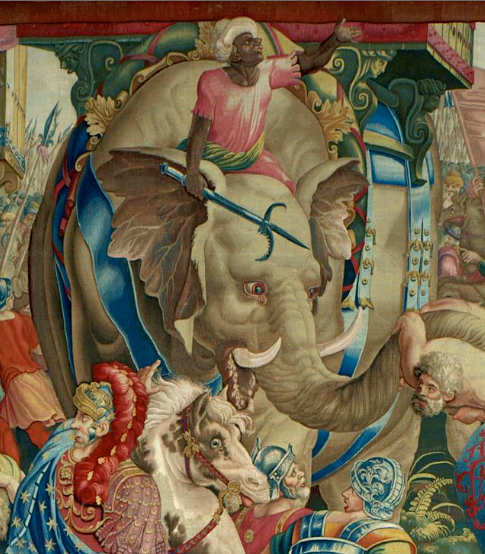I have to check these books out. How good are they? NO ONE is denying that Carthage was mostly indigenous African and that the Numidians were black/African. I think even Euronuts know this. Hell they depicted the native black population of Carthage as black in the TV show Spartacus.
But then we have this...
THE PRESENCE OF AFRICAN INDIVIDUALS IN PUNIC POPULATIONS FROM THE ISLAND OF IBIZA (SPAIN): CONTRIBUTIONS FROM PHYSICAL ANTHROPOLOGY
Nicholas Márquez-Grant*
The golden trade of the Moors: West African kingdoms in the fourteenth century
By E. W. Bovill, Robin Hallet
pp. 21-22
General History of Africa: Ancient civilizations of Africa By G. Mokhtar, Unesco. International Scientific Committee for the Drafting of a General History of Africa
p. 427
We also have the fact that the Phoneticians were so influenced by the Ancient Egyptians that they worshipped the god "Bes" who traces his origins to central Africa.
Diodorus Siculus (Book V. 16), writing in the 1st century BC, stated that Ibiza con- sisted of people from a variety of nationalities. Considering other Punic enclaves, human skeletal remains from Carthage, in North Africa, seem to indicate that there is no clear ethnic unity (Charles-Picard and Charles-Picard, 1958: 129), while epitaphs reveal the possi- ble presence of individuals of Cypriotic and Phoenician origins (Benichou-Safar, 1982: 184).
According to historical sources, the spreading of Punic settlements in western Sardinia since the 4th century BC is associated with peasant and slave immigration from North Africa (van Dommelen, 1997: 313, citing Bondì, 1987: 181). In antiquity, slaves were obtained from areas in the Mediterranean as well as northern Europe (Thompson, 2003: 3-4). In ancient Greece and Rome, some members of society came from sub- Saharan Africa (see Snowden, 1970). In later periods, between the 5th and 8th centuries AD, the Iberian Peninsula and the Balearic Islands also received merchants from the Eastern and Central Mediterranean (García, 1972).
Mediaeval Ibiza has shown similar metric characteristics to mandibles from European Caucasoid, North African and sub-Saharan individuals (Gómez, 1989). Turning to Punic Ibiza, the material culture imported from around 600 BC onwards derives from the Central Mediterranean area. For this reason, it has been suggested that immigrants, especially from Sicily, Sardinia and Carthage, may have been present in Ibiza (Costa and Gómez, 1987: 53; Guerrero, 1997: 240, 248). Moreover, the administration in an urban centre was likely to have high status representatives from Carthage (Guerrero, 1997: 249). This link with North Africa also seems reasonable due to the presence in Ibiza of ostrich eggs (see Astruc, 1957), Egyptian scarabs (see Blázquez, 1967; Fernández and Padró, 1982), possibly the present-day Ibizan hound or ‘ca eivissenc’ (see Pedro, 1996; Cesarino, 1997: 98) and perhaps architecture (see Díes and Matamoros, 1989).
Also, the presence of African individuals may be identified in artefacts such as terracotta figurines (see San Nicolás, 1987). Images of individuals with sub-Saharan physical features do seem to appear in earlier scarabs from Phoenician Ibiza (see Boardman, 2003). Finally, it is also worth noting that the name ‘Ibiza’derives from a Phoenician-Punic word linked to god Bes (Solá, 1956; Tarradell and Font, 1975: 232-233). This god has been represented in many of Ibiza’s Punic artefacts such as coins (see Planas et al., 1989). This deity, originally from the Egyptian pantheon, seems to have its roots in Equatorial Africa (Padró, 1978; Planas et al., 1989: 11). He served the main gods and was considered the protector of birth, sleep, love, marriage, childbirth and sexuality (Fernández, 1996). This evidence,8 however, only indicates an association with North Africa, mainly in terms of economy and culture.
We know for a fact that the indigenous population of Carthage was BLACK. But the fact is the problem lies with Hannibal HIMSELF. All we're saying(at least me that is) is that there is no physical remains of Carthage and most primary classical sources describing him are gone. Not only that while the bulk of Carthage was African, there were many non-African types such as those from Europe and thats a fact. So I don't get how being concerned about the true race of Hannibal is "speculation" when there is no remains of him or hardly any classical sources detailing him. Not only that many outsiders depict him in various ways. But I'll admit that I came across this online. A more later European depiction of Hannibal, but as black.


"The scene, which is based on Livy's account of the second Punic War in his History of Rome (XXX, 33, 4-16), depicts the last battle pitting Scipio and the Roman army against the Carthaginians. Elephants in the Carthaginian army's front lines are charging the Romans, toppling men and horses. On the left, an elephant startled by the blare of a trumpet and a horn turns on its own camp. In the foreground, Scipio, wearing a starry blue mantle, leads his men, urging them to push back the enemy with swords and javelins.The border along the sides and lower edge features a broad garland of flowers, fruits, small animals, and frolicking children. The upper part consists of an architrave, probably to comply with the dimensions requested by the first patron to commission a tapestry on this theme, the Maréchal de Saint-André, whose arms grace the upper corners."
And can you post some of the writings of Mago? That would be interesting.






 . They scratch out and remove the person from all public buildings, documents, art, and currency. Caracalla was eventually assassinated.
. They scratch out and remove the person from all public buildings, documents, art, and currency. Caracalla was eventually assassinated.

 Just wait until they make a movie about Moorish Iberia and blacks having white slaves, white people finna become the new terrorists and blow up theaters and sh*t
Just wait until they make a movie about Moorish Iberia and blacks having white slaves, white people finna become the new terrorists and blow up theaters and sh*t 

 Ain't surprised they haven't done it yet..
Ain't surprised they haven't done it yet.. 


